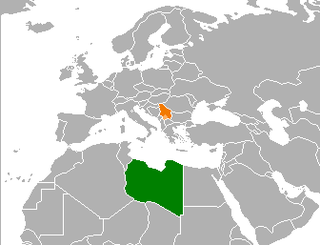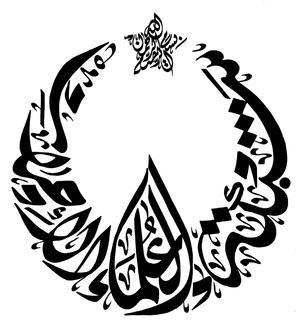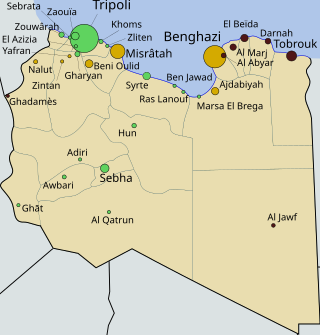
Bayda, or Elbeida ( or ; Arabic: البيضاء al-Bayḍāʾ ), is a commercial and industrial city in eastern Libya. It is located in northern Cyrenaica. With a population of 250,000 people, Bayda is the 4th-largest city in Libya. It is the capital city of the Jabal al Akhdar district.
Zawiya, officially Zawia, is a city in northwestern Libya, situated on the Libyan coastline of the Mediterranean Sea about 47 km (29 mi) west of Tripoli, in the historic region of Tripolitania. Zawiya is the capital of the Zawiya District.

Wanis al-Qaddafi was a Libyan politician. He held many positions in the era of the Kingdom of Libya and was the tenth Prime Minister of Libya from 4 September 1968 to 31 August 1969, when his government was overthrown by Muammar Gaddafi.
The media of Libya consists of a broad range of newspapers, TV channels, radio stations, and websites mostly set up during or after the Libyan Civil War, which removed previously tight restrictions on freedom of the press and freedom of speech. By the summer of 2012, there were over 200 registered newspapers, over 20 TV channels, and 200 radio stations.

Al Abraq International Airport or Al Bayda International Airport is an airport serving the eastern Libyan city of Bayda. The airport is 16 kilometres (9.9 mi) east of Bayda, and 12 kilometres (7.5 mi) south of Libya's Mediterranean coast. The airport is also known as El Beida International Airport or Airport International El Beida la Abraq.

The Kingdom of Libya, known as the United Kingdom of Libya from 1951 to 1963, was a constitutional monarchy in North Africa that came into existence upon independence on 24 December 1951 and lasted until a bloodless coup d'état on 1 September 1969. The coup, led by Muammar Gaddafi, overthrew King Idris and established the Libyan Arab Republic.

Libya–Serbia relations are diplomatic relations between Libya and Serbia. Libya has an embassy in Belgrade and Serbia has an embassy in Tripoli.

The First Battle of Benghazi occurred as part of the Libyan Civil War between army units and militiamen loyal to Libyan leader Muammar Gaddafi and anti-Gaddafi forces in February 2011. The battle mainly took place in Benghazi, the second-largest city in Libya, with related clashes occurring in the nearby Cyrenaican cities of Bayda and Derna. In Benghazi itself most of the fighting occurred during a siege of the government-controlled Katiba compound.

The Khamis Brigade, formally the 32nd Reinforced Brigade of the Armed People, was a regime security brigade of the Libyan Armed Forces loyal to Muammar Gaddafi, the official leader of Libya from 1969 until 2011. The 32nd Brigade was commanded by Gaddafi's youngest son, Khamis Gaddafi and was called "the most well-trained and well-equipped force in the Libyan military" and "the most important military and security elements of the regime" in leaked U.S. memos.

The National Liberation Army, officially the National Liberation Armed Forces of the Free Libyan Republic, formerly known as the Free Libyan Army, was a Libyan military organisation affiliated with the National Transitional Council, which was constituted during the First Libyan Civil War by defected military members and civilian volunteers, in order to engage in battle against both remaining members of the Libyan Armed Forces and paramilitia loyal to the rule of Muammar Gaddafi. Its self proclaimed chief commander was General Khalifa Haftar, although the National Transitional Council preferred to appoint Major General Abdul Fatah Younes Al-Obeidi as its commander-in-chief. It had prepared for some time in portions of Eastern Libya controlled by the anti-Gaddafi forces for eventual full-on combat in Western Libya against pro-Gaddafi militants, training many men before beginning to go on the offensive. They have battled for control of Benghazi, Misrata, Brega, Ajdabiya, Zawiya and Ra's Lanuf as well as several towns in the Nafusa Mountains. They finally began the Battle for Tripoli in August 2011 when they attacked from the west of the city, as well as fomenting an internal uprising on 20 August.

The Network of Free Ulema – Libya is a group of senior religious leaders, or ulama, from all areas of Libya. Due to the persistent's security constraints with families and associates of those opposing Muammar Gaddafi being taken hostage none of the names of members have been released. However, they have been very vocal in the international media throughout the Libyan Civil War, releasing a constant stream of statements, appeals, calls, endorsements, responses and fatwas. Since the liberation of Libya the Network of Free Ulema have formed a larger organization of Libyan religious scholars called the League of Libyan Ulema, headed by Sheikh Umar Abdul Hamid al Mawlud.
Qayqab is a town in the Derna District in northeastern Libya. The town is located on the northeast side of the Akhdar Mountains, south of Al Abraq and Al Abraq Airport and Faydiya lies to the southwest, connected by road.
The Libyan National Democratic Front was a Libyan political opposition organization. The organization was founded in the United States in August 1980, emerging out of the Democratic Libya Committee. The founding meeting elected a Central Committee and adopted the programmes of the organization. The organization coined the phrase "national democratic" which meant protecting the rights of the poor and middle classes, absolute national independence and democratic means of government. Some of its members had a Marxist ideological orientation. Compared to other Libyan opposition groups at the time, the Libyan National Democratic Front had a high degree of ideological and organizational consistency. The organization published the magazine al-Watan on a regular basis. The first issue of al-Watan was issued in September 1980.

The Libyan Civil War began on 15 February 2011 as a chain of civil protests and later evolved into a widespread uprising against the regime of Muammar Gaddafi. On 25 February, most of eastern Libya was reported to be under the control of protesters and rebel forces. Gaddafi remained in control of the cities of Tripoli, Sirte and Sabha. By 15 March, however, Gaddafi's forces had retaken more than half a dozen lost cities. Except for most of Cyrenaica and a few Tripolitania cities the majority of cities had returned to Gaddafi government control.
Safia Farkash Gaddafi is a Libyan businesswoman. She is the widow of former Libyan leader Muammar Gaddafi, former First Lady of Libya and Representative of Sirte, and mother of seven of Gaddafi's eight biological children, some of whom participated in their family's regime.

Gaddafi loyalism, in a wider political and social sense also known as the Green resistance, consists of sympathetic sentiment towards the overthrown government of Muammar Gaddafi, who was killed in October 2011, and his Third International Theory. Despite Muammar Gaddafi's death, his legacy and Jamahiriya ideology still maintains a popular appeal both inside and outside Libya into the present day. Regardless, the Western sentiment has largely been that this continued support may contribute to some of the ongoing violence in Libya.

The Popular Front for the Liberation of Libya is a Gaddafi loyalist militia and political party that aims to elect Saif al-Islam Gaddafi, son of the late Libyan leader Muammar Gaddafi, as president of Libya.

The 1993 coup d'état was a failed military coup initiated by the Warfalla senior military officers against Libyan leader Muammar el-Qaddafi on 22 October 1993. The coup was led by Khalifa Haftar, a leading senior officer in the Libyan Army who later defected during the coup. The result was the execution of many senior officers and the installment of loyal members.

In early 1972, Gaafar Nimeiry visited Saudi Arabia and engaged in dialogue with Sharif Hussein al-Hindi, the opposition leader, at the request of King Faisal of Saudi Arabia. The dialogue revolved around addressing past grievances and the political landscape. Nimeiry attributed past massacres to communists while Sharif criticised Nimeiry's regime. Offers and suggestions were exchanged, including Nimeiry proposing the Vice Presidency to Sharif, but no agreement was reached. Disappointed with the outcome, Sharif planned an attack on Khartoum with Libyan support.

The Al-Ghiran Brigade(s), originating from Misrata, was a brigade formed with the purpose of safeguarding the Al-Ghiran region against pro-Gaddafi factions during the battle of Misrata. This brigade is known for being the one to capture Muammar Gaddafi, and eventually killing him after 8 months of fighting.













